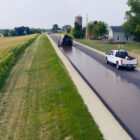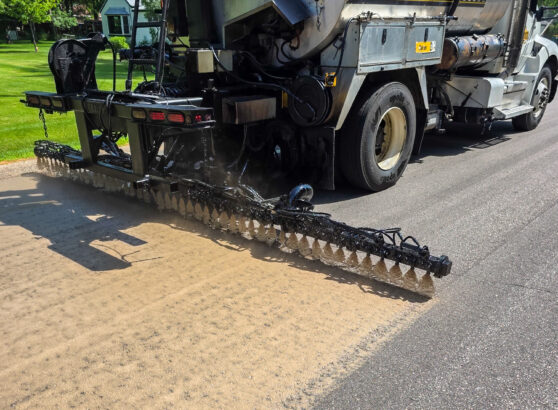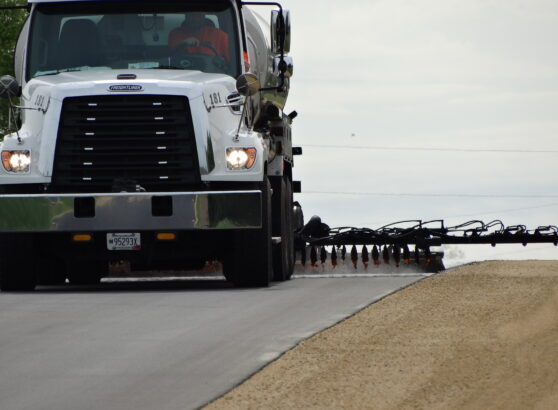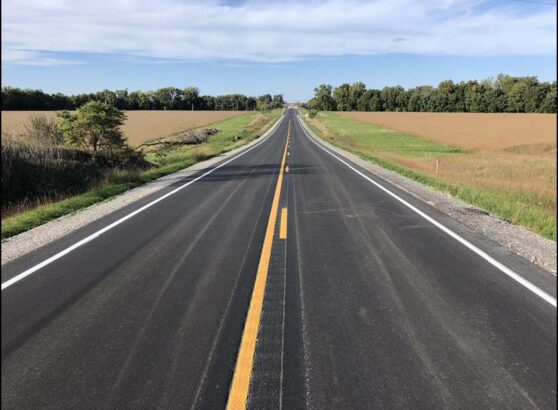Drivers are distracted now more than ever. Whether it be falling asleep behind the wheel or texting while driving, drivers are not paying attention to the roads. So, it is important to invest in a proven safety tool, centerline rumble strips (CLRS). Though rumble strips save lives, they may reduce the life and performance of the centerline joint.
By applying J-Band®, Asphalt Material Inc.’s (AMI) void reducing asphalt membrane (VRAM) product, and AMIGUARD™, Asphalt Material Inc.’s rapid penetrating emulsion (RPE), you can protect the joint, the pavement and the lives of workers and drivers alike.
NRRA and MNDOT Research Case Study
To prove the effectiveness of a VRAM and RPE as a pre-treatment for the deterioration of centerline rumble strips, a proposal to study these materials on local roadways was submitted in response to a call for innovation by the National Road Research Alliance (NRRA) in 2023. The project proposal was ultimately selected for funding by the voting agencies.
Project Team
Principal Investigators: Dan Swiertz, PE, AMI; Katie DeCarlo, PhD, Heritage Research Group; Signe Reichelt, PE, Behnke Materials Engineering
Technical Liaison: Tyler Hunt, Michigan DOT
Project Technical Advisory Panel (TAP): Ashley Buss, Iowa DOT; Doug Carlson, Liberty Tire; Stephen Cooper, FHWA; Jerry Geib, MnDOT; Ian Gilhooly, IDOT; Rob Green, MDOT; Josh Heck, MDT; Joseph Podolsky, MnDOT; Phillip Ruffus, MoDOT; Joel Ulring, MnDOT; Michael Vrtis, MnDOT

To test the effectiveness of a VRAM and RPE on rumble strips, three construction sites were chosen in partnership with county highway agencies in the state of Wisconsin: Sheboygan County, Wood County and Rock County. Each highway had a control section with rumble strips, a VRAM section and a RPE section, and these same sections without rumble strips.
Road cores were taken in each of the research sections for laboratory testing and evaluation. Mixture samples were taken during the paving process will being used as calibration for the respective field core measurements.



VRAM (J-Band) Compared to RPE (AMIGUARD)
J-Band is a polymer modified asphalt material and is hot applied. It is used in conjunction with a tack coat between the pavement layers and typically applied in an 18’’ band and placed on the centerline of the intended joint location. The first paving pass of the application covers around 9’’ inches, and the second paving pass covers the remaining.


So, how does it work? VRAM works its way into the pavement mixture from the bottom up. By migrating upwards it fills voids and other elements such as air and water. The performance of the mixture at the joint becomes more controlled by asphalt properties such as elasticity and ductility. The mixture at the joint is nearly 100% impermeable, enhancing the durability benefits of using VRAM.
RPE on the other hand is a liquid asphalt emulsion and is spray applied with a standard distributor. RPE is designed to physically permeate the mixture structure from the top down. The application is applied at a full lane width or at the centerline only depending on project preference. When applied, an unaged binder material fills the interconnected void structure. Since the product penetrates through the material, the residue will not wear off like typical fog seal. The macro-texture of the pavement is therefore maintained and is nearly 100% impermeable from the surface.


Field Sampling and Testing Plan
Cores taken from the three projects will undergo testing at the Heritage Research Group laboratory. The laboratory work plan includes measurements of physical properties and performance, such as crack resistance. Test methods are selected to better understand the potentially detrimental effects that installation of centerline rumble strips have on mixture durability and determine whether VRAM and/or RPE can offset these effects.
Below you can learn more about the expected outcomes of each test method. In addition to the road cores, the research team plans to conduct rumble strip functionality testing (noise and vibration) in the spring of 2024 to verify the material treatments do inhibit the rumble strip from performing as a safety tool.




Conclusion
The frequency of centerline rumble strip installation is increasing nationwide, and for good reason: they save lives. But agencies should not neglect the potential impact installation of rumble strips may have on mixture performance. The outcome of this study is expected to provide agencies with a toolkit of proven solutions to keep rumble strips, and their pavements, performing at a high level.
Although this study will not be completed until 2025, preliminary results will be shared via project quarterly reports, which are posted on the project NRRA website. These projects will also provide years of useful data that may warrant future research.
The next time you think about installing rumble strips, remember, with the help of VRAM and RPE you can preserve their life-saving benefits!
Wisconsin County Highway Departments are on the leading edge of using these innovative materials! To learn more about Asphalt Material’s product portfolio, click here.















Recent Comments